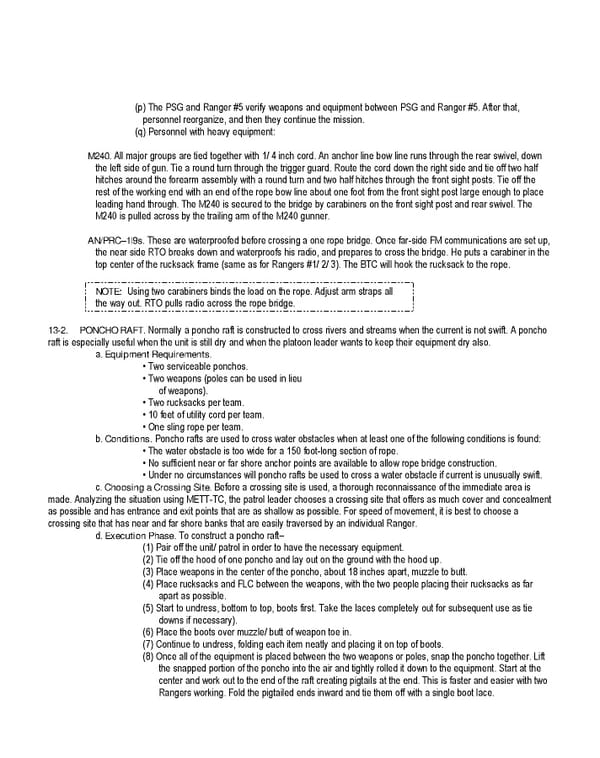(p) The PSG and Ranger #5 verify weapons and equipment between PSG and Ranger #5. After that, personnel reorganize, and then they continue the mission. (q) Personnel with heavy equipment: M240. All major groups are tied together with 1/ 4 inch cord. An anchor line bow line runs through the rear swivel, down the left side of gun. Tie a round turn through the trigger guard. Route the cord down the right side and tie off two half hitches around the forearm assembly with a round turn and two half hitches through the front sight posts. Tie off the rest of the working end with an end of the rope bow line about one foot from the front sight post large enough to place leading hand through. The M240 is secured to the bridge by carabiners on the front sight post and rear swivel. The M240 is pulled across by the trailing arm of the M240 gunner. AN/PRC–1l9s. These are waterproofed before crossing a one rope bridge. Once far-side FM communications are set up, the near side RTO breaks down and waterproofs his radio, and prepares to cross the bridge. He puts a carabiner in the top center of the rucksack frame (same as for Rangers #1/ 2/ 3). The BTC will hook the rucksack to the rope. NOTE: Using two carabiners binds the load on the rope. Adjust arm straps all the way out. RTO pulls radio across the rope bridge. 13-2. PONCHO RAFT. Normally a poncho raft is constructed to cross rivers and streams when the current is not swift. A poncho raft is especially useful when the unit is still dry and when the platoon leader wants to keep their equipment dry also. a. Equipment Requirements. • Two serviceable ponchos. • Two weapons (poles can be used in lieu of weapons). • Two rucksacks per team. • 10 feet of utility cord per team. • One sling rope per team. b. Conditions. Poncho rafts are used to cross water obstacles when at least one of the following conditions is found: • The water obstacle is too wide for a 150 foot-long section of rope. • No sufficient near or far shore anchor points are available to allow rope bridge construction. • Under no circumstances will poncho rafts be used to cross a water obstacle if current is unusually swift. c. Choosing a Crossing Site. Before a crossing site is used, a thorough reconnaissance of the immediate area is made. Analyzing the situation using METT-TC, the patrol leader chooses a crossing site that offers as much cover and concealment as possible and has entrance and exit points that are as shallow as possible. For speed of movement, it is best to choose a crossing site that has near and far shore banks that are easily traversed by an individual Ranger. d. Execution Phase. To construct a poncho raft– (1) Pair off the unit/ patrol in order to have the necessary equipment. (2) Tie off the hood of one poncho and lay out on the ground with the hood up. (3) Place weapons in the center of the poncho, about 18 inches apart, muzzle to butt. (4) Place rucksacks and FLC between the weapons, with the two people placing their rucksacks as far apart as possible. (5) Start to undress, bottom to top, boots first. Take the laces completely out for subsequent use as tie downs if necessary). (6) Place the boots over muzzle/ butt of weapon toe in. (7) Continue to undress, folding each item neatly and placing it on top of boots. (8) Once all of the equipment is placed between the two weapons or poles, snap the poncho together. Lift the snapped portion of the poncho into the air and tightly rolled it down to the equipment. Start at the center and work out to the end of the raft creating pigtails at the end. This is faster and easier with two Rangers working. Fold the pigtailed ends inward and tie them off with a single boot lace.
 Ranger Handbook Page 239 Page 241
Ranger Handbook Page 239 Page 241